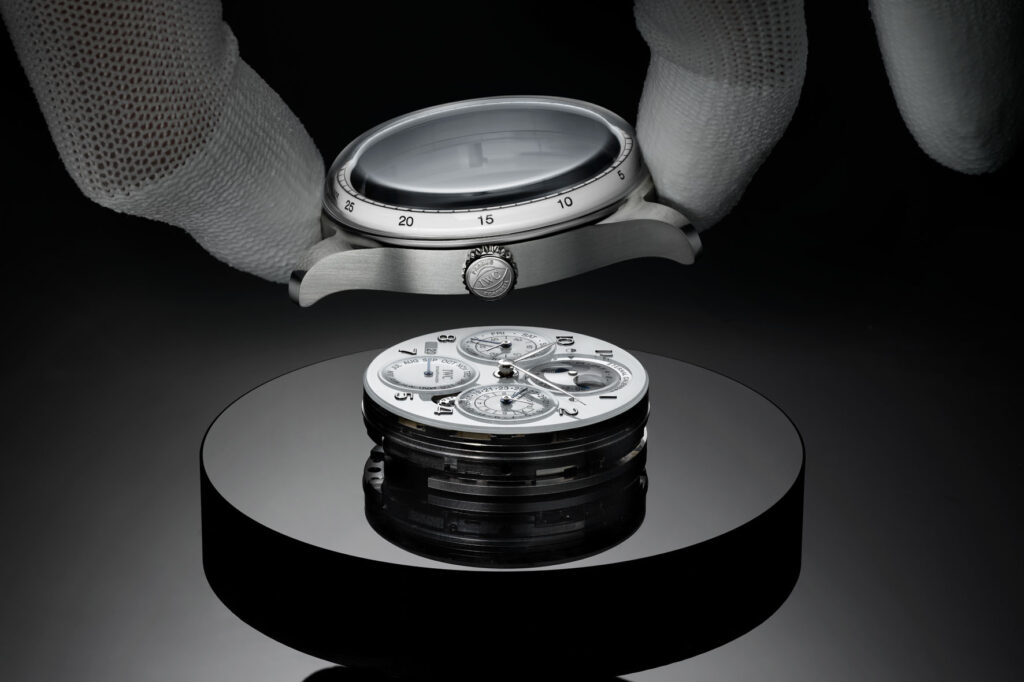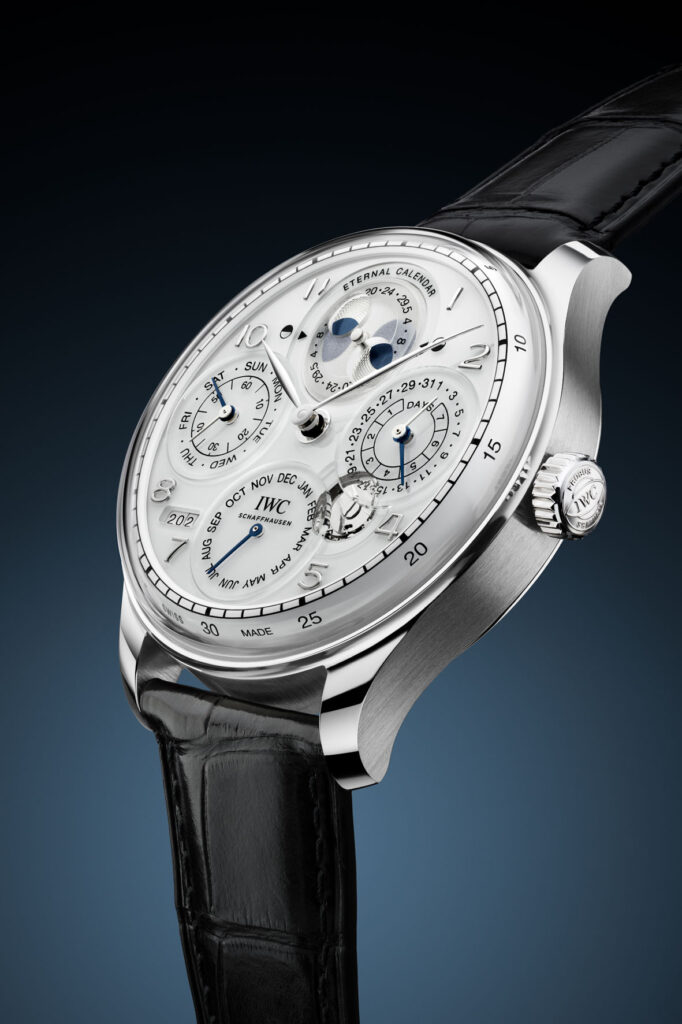Tribute to eternity: IWC Portugieser Eternal Calendar
8 May 2024Among the latest innovations unveiled at this year’s Watches & Wonders 2024, IWC went beyond its iconic perpetual calendar with dual moon phase display and once again pushed the boundaries of watchmaking by developing a truly record-breaking mechanism.

Due to the inherent complexities of the Gregorian calendar, watches with a traditional perpetual calendar require a small manual adjustment in the years 2100, 2200 and 2300 (non-leap years). The new IWC Portugieser Eternal Calendar, on the other hand, is equipped with the brand’s first secular perpetual calendar movement, which automatically takes the exceptions of the Gregorian calendar into account up to the year 3999 (skipping three leap years out of 400 years) and features a moon-phase display with an astonishing accuracy of no less than 45 million years!
KURT KLAUS LEGACY
Invented in the early 1980s by IWC’s master watchmaker Kurt Klaus, the perpetual calendar module was designed to transpose the Gregorian calendar, with all its dissimilarities, into a watch. It was first introduced in the 1985 Da Vinci Perpetual Calendar (as an addition on a Valjoux 7750 base). Ingeniously, and with a total of 81 components, the calendar incorporated several revolutionary solutions. It introduced the absence of correctors on the case, i.e. the perfect synchronization, via the crown alone, of all indications: date, day of the week, month and the moon phases. And for the first time, a perpetual calendar featured a four-digit year display and an extremely precise moon phase display (to be corrected by one day only after 122 years).

Over the years, the original calendar module has been refined and slightly modified. Technical improvements include an upgrade of the safety systems that protect the mechanism and an improvement on the accuracy of the moon phase, which deviates from the actual phase of the moon by only one day after 577.5 years.
In 2003, this iconic complication was also introduced for the first time in the Portugieser collection. And to this day, the Portugieser Perpetual Calendar with a double moon phase display (northern and southern hemispheres) has remained one of IWC’s milestones.
THE SECULAR PERPETUAL CALENDAR
The leap year cycle of the Gregorian calendar, consisting of three common years and a leap year, is itself subject to a secular correction system, which “skips” a leap year every 100 years. Consequently, most perpetual calendars require a “hard reset” by a watchmaker in the year 2100.

A secular calendar, on the other hand, doesn’t require any corrections, since it takes into account all the known rules and exceptions of the Gregorian calendar.
The secular perpetual calendar is one of the rarest and most prestigious complications in watchmaking and until last year, only a few brands could boast its creation and configuration in a watch: Patek Philippe with the Calibre 89 astronomical pocket watch (made in 1989 to celebrate the company’s 150th anniversary), Andersen Genève with the Perpetual Calendar Secular (made by Svend Andersen in 1996), Franck Muller with the Aeternitas Mega 4 and the two contemporary Audemars Piguet Code 11. 59 Universelle and Furlan Marri Perpetual Calendar (made with Dominique Renaud and Julien Tixier for Only Watch 2023).
These brands are now joined by IWC Schaffhausen with the Portugieser Eternal Calendar reference IW505701, which doesn’t require any corrections until the year 3999 (since it has not yet been decided whether the year 4000 will be a leap year or not).
The Portugieser Eternal Calendar works on the same modular and synchronized structure as the perpetual calendar originally designed by Kurt Klaus to which an additional secular module is added that makes a complete revolution every four years at the end of February.
THE MOON PHASE ACCURACY RECORD
The original Da Vinci (Ref. IW3750) from 1985 had an accuracy of the moon phase display to be corrected by just one day after 122 years, while in 2003, the brand upgraded its standards with the Portugieser Perpetual Calendar (Ref. IW5021), bringing the accuracy of the complication to 577.5 years. The new IWC Portugieser Perpetual Calendar has a double moon phase display that will deviate from the moon’s orbit by just one day after 45 million years. IWC says it used a computer program to simulate more than 22 trillion different combinations in order to find the precise and optimal balance between the amount of wheels used, the proportions and the number of teeth.

The Guinness World Record for the most accurate moon phase display was awarded in 2014 to Andreas Strehler, whose Lune Perpétuelle has a deviation of one day in two million years, while today IWC with the Eternal Calendar has managed to break this record with a display that is 22 times more accurate!
THE NEW PORTUGIESER ETERNAL CALENDAR
The Portugieser Eternal Calendar features a platinum case with a polished and brushed finish, 44.5 mm in diameter and 15 mm thickness (wider proportions than the 44.2×14.9 mm of the Portugieser Perpetual Calendar). The dial, of similar complexity to its mechanical counterpart, is made of glass and the lower part of it is satin-finished and lacquered in white. The counters are machined, polished separately and then inserted into the main dial. This is followed by the printing of numerals, scales and text, and the manual insertion of applied hour markers and rhodium-plated hands. The Portugieser’s characteristic numerals and minute track are printed on a white lacquered flange between the glass dial and the front glass. Finally, the watch is completed by a sapphire crystal with an arched edge on both the dial side and the back side.
THE IN-HOUSE CALIBRE IWC52640
Inside the platinum case is the new IWC-manufactured 52640 calibre movement. This calibre is based on the automatic movement from the 52000 family (over 38 mm in diameter) and incorporates the Pellaton winding system made of zirconium oxide ceramic. Exploiting the rotor’s movements in both directions, it accumulates a seven-day (approx. 168 hours) power reserve in two sequential barrels. The movement, finely decorated with perlage and Côtes de Genève, can be observed through the sapphire crystal back, which also allows a view of the large 18-carat pink gold rotor.

CONCLUSION AND PRICE
The Portugieser Eternal Calendar is fitted with a black alligator strap from the Italian shoemaker Santoni with a platinum deployant buckle and is available at a price of € 175,000.

This watch is an effigy of eternity not only on the technical front. It represents the continuum of almost 40 years of study, research, dedication and sacrifice by master watchmaker Kurt Klaus, whose echoes “resonate” between past, present and future.
By Luca Barone




